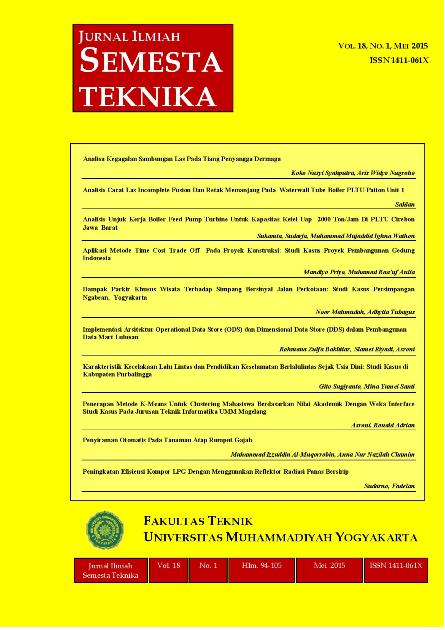Analisa Kegagalan Sambungan Las Pada Tiang Penyangga Dermaga
DOI:
https://doi.org/10.18196/st.v18i1.700Keywords:
Failure analysis, welding, crackAbstract
Welded join failure analysis of broken jetty head strut has been carried out to find out the root cause of the failure which was obverved at the ring welding. Specimens being made of unbroken and broken struts were characterized and analyzed. The results show that the chemical composition of the based metal and the strut welded joins especially their phosporus content were close to that of the ASTM A 252 grade 2 standard. A common phenomenon was noted on the hardness testing result where the hardness numbers of the weld metal zone were found being higher than those of the base metal. The Widmanstatens stucture was noticed on both the weld metal and the coarse grain zone. Further examination of the macrostructures revealed that blow holes and incomplete fusions were detected on the weld metal of the broken struts. These flaws may the root cause of the failure because they acted as an initial crack that may propagate until fracture.Downloads
Published
2016-01-09
How to Cite
Syahputra, K. N., & Nugroho, A. W. (2016). Analisa Kegagalan Sambungan Las Pada Tiang Penyangga Dermaga. Semesta Teknika, 18(1), 1–9. https://doi.org/10.18196/st.v18i1.700
Issue
Section
Articles
License
Semesta Teknika is licensed under a Creative Commons Attribution 4.0 International License.
Authors who publish with this journal agree to the following terms:
- Authors retain copyright and grant the journal right of first publication with the work simultaneously licensed under a Creative Commons Attribution License that allows others to share the work with an acknowledgement of the work's authorship and initial publication in this journal.
- Authors are able to enter into separate, additional contractual arrangements for the non-exclusive distribution of the journal's published version of the work (e.g., post it to an institutional repository or publish it in a book), with an acknowledgement of its initial publication in this journal.
- Authors are permitted and encouraged to post their work online (e.g., in institutional repositories or on their website) prior to and during the submission process, as it can lead to productive exchanges, as well as earlier and greater citation of published work (See The Effect of Open Access).









